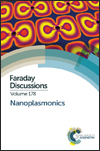A surface plasmon enabled liquid-junction photovoltaic cell
Abstract
Plasmonic nanosystems have recently been shown to be capable of functioning as photovoltaics and of carrying out redox photochemistry, purportedly using the energetic electrons and holes created following plasmonic decay as charge carriers. Although such devices currently have low efficiency, they already manifest a number of favorable characteristics, such as their tunability over the entire solar spectrum and a remarkable resistance to photocorrosion. Here, we report a plasmonic photovoltaic using a 25 μm thick electrolytic liquid junction which supports the iodide/triiodide (I−/I3−) redox couple. The device produces photocurrent densities in excess of 40 μA cm−2, an open circuit voltage (Voc) of ∼0.24 V and a fill factor of ∼0.5 using AM 1.5 G solar radiation at 100 mW cm−2. The photocurrent and the power conversion efficiency are primarily limited by the low light absorption in the 2-D gold nanoparticle arrays. The use of a liquid junction greatly reduces dielectric breakdown in the oxide layers utilized, which must be very thin for optimal performance, leading to a great improvement in the long-term stability of the cell's performance.
- This article is part of the themed collection: Nanoplasmonics

 Please wait while we load your content...
Please wait while we load your content...